
This is the part of Tamil Nadu I was most smitten by. Colourful and packed with gods, goddesses, myths and secular life, its gopurams are a peculiar feature unique to the state. True, gopurams or entrance towers are a part of temple architecture across southern India. But in Tamil Nadu, they have a life of their own, larger in design and scale than the overshadowed holy sanctums inside the temple complexes. They are pure art. And I loved them.
I visited scores of temples during my week-long exploration of the southern state’s temple towns. From the incredible Meenakshi Amman Temple in Madurai celebrating the town’s beautiful and gracious patron goddess to the ancient Pillaiyarpatti Temple in Chettinad, site of an electrifying abhishek ceremony of the god Ganesha.
From the Nataraja Temple in Chidambaram, the only Hindu temple to worship Shiva as Nataraja, the Lord of Dance, to Thirukadaiyur Temple on the outskirts of Tranquebar where married couples celebrate their 60th, 70th, and 80th wedding anniversaries for it is renowned to defy death!
From the monumental Sri Ranganathaswamy Temple in Tiruchirappalli, India’s largest functioning temple and a mini-city in itself with a whopping 21 gopurams, to the string of lively temples lining the streets of Kumbakonam where I temple-hopped from one to the other for a different kind of night-life.
Dedicated to various deities, one architectural feature yet bound them all together. Their animated, multi-coloured, towering gopurams.

An ornate Dravidian architectural element guided by Vaastu Shastra, they rose in prominence from the 12th to 16th Centuries, with temples often having gopurams placed in all cardinal directions, and on every enclosing boundary wall. They are typified with multiple tapering floors called talas, topped with a barrel-vaulted roof, and choc-o-bloc with sculpted, brilliantly-painted tableaux and solo divine beings. Though themed around the temple’s primary deity, the entire pantheon is on display on their outer walls. The tallest gopuram in India is at Sri Ranganathaswamy Temple in Tiruchirappalli at a flabbergasting 72 metres height.
For the uninitiated, the Hindu pantheon is centred around the trinity: Shiva the destroyer, Vishnu the preserver and Brahma the creator, along with their various avatars, consorts, children and vehicles. The seemingly polytheistic religion is yet a monotheistic one, for every deity is believed to be a manifestation and point of focus of the single supreme truth—Brahman.
Gopurams can be overwhelming. And at the same time a delight to decode, the stories they contain a visual insight into the complexities of one of the oldest practiced religions in the world.
Here are my favourites images from the various gopurams I got to see and the stories in them. They are made of stucco and brick and painted brightly, as was, and still is, the tradition in Tamil Nadu. Gopurams with stucco work are unique to South India, and in particular Tamil Nadu.
This post would not have been possible if it were not for the inputs towards identifying the stories in the gopurams by a dear blogger friend, a Tamil and fellow Mumbaikar, Sudha Ganapathi who blogs at sudhagee.com. She is an absolute pro at Hindu iconography and her help in enriching this post has been invaluable. Thank you, Sudha.
So, here goes, Tamil Nadu’s temple gopurams: Stories told and untold. I hope you enjoy this post as much as I did putting it together. ❤

What better way to start than with the marriage of Meenakshi and Sundareshwarar [Beautiful Shiva] in Tamil Nadu’s most celebrated temple. Vishnu is seen doing the Kanyadaan ‘Giving away the bride’ rituals in his capacity as her brother, while Brahma is the officiating priest. Note: It is always Shiva and Parvati. Any other goddess appearing as his consort is simply one of Parvati’s avatars. Meenakshi, the patron goddess of Madurai is, likewise, an avatar of Parvati. [Meenakshi Amman Temple, Madurai]
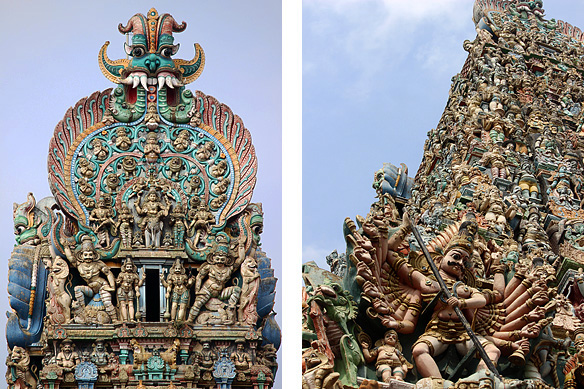
Left: Makara finial on the gopuram roof filled with guardian deities and Indra, the sky god, on his elephant. Right: Shiva as Virabhadra, his ‘fierce’ avatar, with the glorious south gopuram reaching out to the skies behind him. [Meenakshi Amman Temple, Madurai]

The stories continue. Left: Kali, one of Hinduism’s most complex goddesses. She is the destroyer of evil forces, embodiment of female power, and goddess of time and death. Kali literally means ‘She who is black’ or ‘She who is death.’ An incarnation of Parvati, she was Shiva’s consort in another life. Right: Sadashiva, Always Shiva. The highest form of Shiva. [Meenakshi Amman Temple, Madurai]

Shiva as Veenadhara Dakshinamurthy, guru of all knowledge, understanding and awareness, with a veena in his hands, surrounded by his students: sadhus and wise animals. [Meenakshi Amman Temple, Madurai]

This is Murugan or Kartikeya, the War God, seated on his peacock. He is Shiva and Parvati’s elder son, as per South Indian traditions [North Indians believe he is the younger son], and the chief deity of Tamils since ancient times. [Meenakshi Amman Temple, Madurai]

Moving on to the ancient rock-cut Ganesha temple in Chettinad. Left: Guardian angels and holy cows guard the sanctum depicted on the gopuram. Right: Detail, Ravana shaking Mount Kailash. The epic Ramayana recounts how Ravana once tried to lift Mount Kailash in a fit of misplaced pride but Shiva pushed the mountain into place with his mere toe. Trapped under the mountain, Ravana shrieked out in pain and that’s where he got his name from: Ravana, ‘the one who cried.’ [Pillaiyarpatti Temple, Chettinad]

Another guardian angel. Figures like these often dot the entire boundary walls of Shiva temples. [Pillaiyarpatti Temple, Chettinad]
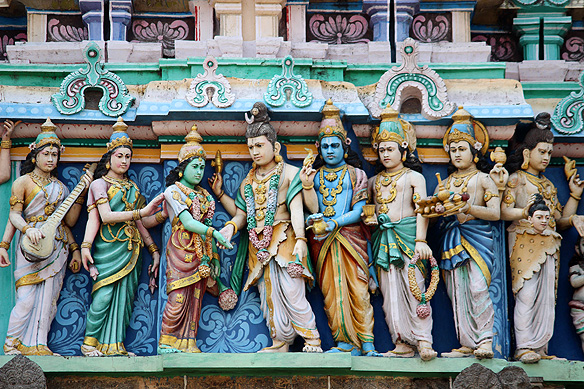
Chidambaram’s Nataraja Temple has Tamil Nadu’s most beautiful tableaux on its gopurams. Life-like in their facial expressions, they depict entire scenes in Hindu mythology. Here, Shiva is seen marrying Uma. In South India, Parvati, Shiva’s consort is always Uma, except in Madurai. Lakshmi and Saraswati, the consorts of Vishnu and Brahma, stand next to her as her bridesmaids. 🙂

Ganesha, Shiva’s elephant-headed son, with his wives Riddhi and Siddhi to the left, in varada mudra, granting boons to the faithful. The tableau is a little unusual as in the South, Ganesha is considered to be a bachelor. Also seen are Brahma and Lakshmi joining in the dispersal of blessings. [Nataraja Temple, Chidambaram]

Did this one take you by surprise? Historical India was intrinsically emancipated, with nudity and sex simply accepted. The naked male figure is Shiva in his avatar as Bhikshatana-murti or the Supreme Beggar and the half-naked women are rishipatnis, wives of the rishis, who have fallen for Shiva. [Nataraja Temple, Chidambaram]

Virabhadra, the ‘distinguished hero’ and fierceness personified avatar of Shiva, killing a demon. Also seen is Yama, god of death and king of ancestors, on the extreme left seated on his buffalo and with a noose in his hand to catch souls. [Nataraja Temple, Chidambaram]

Left: Scene from Kiratarjuniya [Arjuna and the Mountain Man], a 6th Century Classical Sanskrit epic poem with Arjuna, the bearded guy praying on one foot [notice the bow against the tree] and Uma/ Parvati disguised as a huntress. The dead boar which is barely visible confirms the story. Right: Just a pair of pretty human ladies dancing in one corner, amidst the bevy of gods and goddesses. [Nataraja Temple, Chidambaram]

Brahma, the three-headed god of creation, first god of the Hindu trinity, and patriarch of human beings. [Nataraja Temple, Chidambaram]

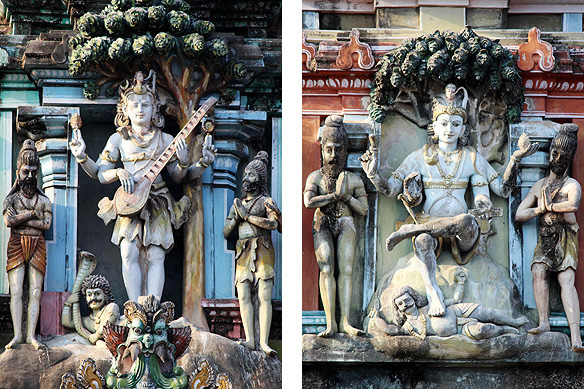
I loved this collection of Shiva as Dakshinamurthy or Shiva as the Supreme Guru or Teacher lined up vertically, one above the other along the gopuram’s entire height. Once again, a form of Shiva that is almost exclusive to South India. The one with the Veena [left] is called Veenadhara Dakshinamurthy, the other three are Jnana or Vyakhyana Dakshinamurthys. [Thirukadaiyur Temple, Tranquebar]
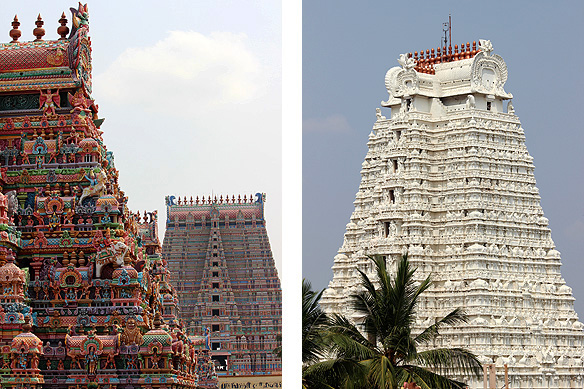
Twenty-one gopurams of Sri Ranganathaswamy Temple, Tiruchirappalli. Of which one, and only one, is in white in honour of a devadasi’s [a hereditary female dancer in a Hindu temple] sacrifice. Her name was Vellaiammal. She threw a robber off the top, followed by jumping down to her own death.
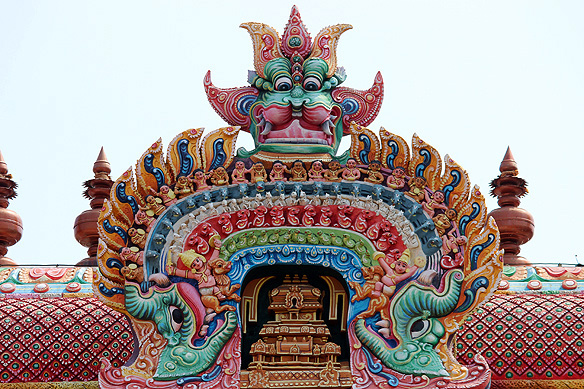
Another makara finial atop a gopuram. No stories here. Just pure unadulterated decoration made up of rows of teeny-meeny musicians, elephants, horses and a medley of creatures welcoming the pilgrims. [Sri Ranganathaswamy Temple, Tiruchirappalli]

Blue-skinned Krishna, the eighth avatar of Vishnu, and one of his most popular avatars now globally. To his right is Vishnu’s vehicle Garuda, a mythical creature half eagle-half human, highlighting Krishna’s Vishnu connect, lest one forgets. [Sri Ranganathaswamy Temple, Tiruchirappalli]

From the grotesque to the serene! Left: Krishna suckling the demoness Putana. The story goes, Putana was sent by Krishna’s evil uncle Kansa to kill him by breast-feeding him poisoned milk. Krishna, being god, knew what she was up to. He squeezed her breasts and killed her instead. Right: Suryanarayana, the Hindu Sun God with a lotus in each hand and a crown. [Sri Ranganathaswamy Temple, Tiruchirappalli]

Varaha, the boar-headed third avatar in Vishnu’s 10 avatars, and his consort Bhudevi, the earth goddess, who he saved from the demon Hiranyakashyap. With her seated on his lap, the couple are referred to as Bhuvaraha. An apt end for this post in COVID-19 times. A prayer for our earth. Don’t you agree? [Sri Ranganathaswamy Temple, Tiruchirappalli]
– – –
[Note: This blog post is part of a series from my solo and independent travel to the temple towns of Tamil Nadu over 7 days in the first week of March 2020. To read more posts on my temple town series and on Tamil Nadu, click here.]

भारतीय सभ्यता और संस्कृति के गवाह के रूप में महान ऐतिहासिक जगह तमिलनाडु को मेरा प्रणाम
LikeLiked by 4 people
Absolutely. Very well said. My apologies for not replying in Hindi. I am more comfortable in English, but rest assured I can read and understand Hindi just fine. 🙂 Thank you for sharing your thoughts here.
LikeLiked by 2 people
महसूस करना और भावनाओं को समझ जाना यह हिंदुस्तानियों का सरल स्वभाव ही वंदनीय है भविष्य में अगर मुझे कभी घूमने का मौका मिला तो मैं जरूर तमिलनाडु की तरफ अपना रुख करूंगा
LikeLiked by 2 people
Our rich heritage. The first thing that strikes is the intricacy. We have to salute the sculptors, their work still standing the test of time.
I thoroughly enjoyed the stories that are often the source of such beautiful tableau, panels and likes.
LikeLiked by 2 people
It is indeed impressive, Monika. Working with their hands, unaided by any modern technology on those tapering, towering gopurams, creating figure after figure. Each sculpture flawless in its narration and infused with so much life. The artisans were true artists. Did you notice the expressions on the Nataraja Temple gopurams’ tableaux? Gosh. They looked so real I got goose bumps! And the colours. It is a world full of gods and goddesses at play and enacting their myths. I am so glad you enjoyed the post and the stories. 🙂
LikeLiked by 1 person
Every time I visit South India, I wonder why these are so colorful? Last year while waiting in a line at Madurai Meenakshi Temple, I assumed the reason for being so colorful must have been because of stone used here, Unlike sandstone or marble, the hard granite (or something similar) doesn’t bring out the carving so well. So maybe this is one of the reasons. I’m not sure though.
LikeLiked by 3 people
Hello Arvind, these gopurams are not made of granite or any stone. Instead they are made of stucco and brick–a gopuram style unique to Tamil Nadu. They are painted brightly, just like the interiors, again as per Tamil tradition. What I also noticed in my travels through the state, was the local populace’s love for colour! Whether it be their bright sarees, gopurams or the walls of their homes. And they carry it off so well.
LikeLiked by 1 person
Ok. Thanks for the information, Rama. You have solved a riddle for me. 😊
LikeLiked by 2 people
It’s so much interesting to see those intricate gopurams explained like this. I remember the first time I saw a Tamil temple in Kuala Lumpur, Malaysia. It was just a small temple, but I was enchanted nonetheless for it was unlike anything I had seen before. Then four years later, I went to Tamil Nadu. My friend and I actually stayed just a short walk away from the Meenakshi Amman Temple. The gopurams were amazing, despite the rather cloudy day.
LikeLiked by 3 people
Credit for the pointers on the meanings go to Sudha Ganapathi as mentioned in the post. I knew what some meant, but most were a question mark. She helped with identifying the myths. Come to think of it, these gopurams are like huge story books! You were lucky to live close by. I stayed a 10 minute auto-rickshaw ride away. When I think of Tamil Nadu now, the first thing that comes to mind are its gorgeous, colourful gopurams bursting with life. 🙂
LikeLiked by 2 people
Wow…such intricate work! Those temples, carvings and the story behind it is beautiful. Thank you for sharing Rama! I love your blog. 😊
LikeLiked by 2 people
Thank you, Nanchi for your kind words. I truly appreciate them. You have a pretty awesome blog yourself!
I have only shared a tiny part of the gopuras. There are so many more stories and sculptures. These gopuras are a whole world in themselves. 🙂
LikeLiked by 1 person
Packed with gods indeed! The beautiful colors of these temples stand out in southern India making them a joy to visit.
LikeLiked by 2 people
Welcome to my blog, Brandy. Needless to say, I was completely enamoured by these gopurams. 🙂 They are quite unlike anything else in India. I am glad you made it back to Italy. Stay safe and healthy.
LikeLiked by 2 people
Thank you for sharing all this. I like indian culture very much.
LikeLiked by 2 people
Hello Aparna, all the way from Denmark. I love your bhajans. They are so peaceful. A suggestion. Perhaps you could do a longer recording, say at least for 10 minutes. Your listeners, including me, could then use it for our meditations. 🙂
LikeLiked by 1 person
Pingback: palaces of madurai and thanjavur | rama arya's blog
Pingback: photo essay: tamil nadu’s colourful gopurams, stories told and untold – Wake up
Very informative, I liked it very much😍👍
LikeLiked by 2 people
Thank you, Arun. Happy to have you here. I was pretty impressed reading your profile, especially the part on being a world record holder on freestyle robotic dance! Hope you continue to enjoy reading my blog. 🙂
LikeLiked by 1 person
😊😊👍
LikeLiked by 1 person
Very Informative article.Thanks for spreading the knowledge.
LikeLiked by 2 people
Am happy you liked the post, Abhishek. Thank you for stopping by and commenting. Where there is knowledge there is understanding. And where there is understanding there is peace and respect. Hope you agree. 😊
LikeLiked by 2 people
Yes. Absolutely.
LikeLiked by 1 person
Rama dee I think do not like my post someone else why dee my post is not good please reply me I m sorry dee again and again I m Comment u for seggestion because on this site I can not seen of Indian ur Indian so I’m comfortable to say this
LikeLike
Karishma, no problem, please feel free to ask. 🙂 Blog ko establish hone mein time lagta hai. Kaafi saara time aur kai baari bahut promotion bhi. Aapne abhi likhna shuru kiya hai. Aap apne posts ko social media mein share karein. Apne friends aur family ke saath share karein. Aur bahut zaroori–likhte rahein. Regularly likhoge toh google unko pickup karega, par uske liye aapko hindi script mein likhna padega. Hope the above helps. Good luck!
LikeLike
Hindi script Mtlb dee Hindi pure Hindi m Dee Ye btao Mujhe kuch help milega site se dee m chahti Hu m apni study K liye kuch Acha likhu or Mj finance help b mile kya ap btaoge dee mj support milega google se
LikeLike
हिंदी स्क्रिप्ट मे। देवनागरी स्क्रिप्ट, जैसे के मैं यह लिख रही हूँ। I don’t know about Google as I have never monetized my site. Good luck.
LikeLiked by 1 person
ठीक है दी
LikeLiked by 1 person
🙂
LikeLike
Great post thnx to share this .
LikeLiked by 1 person
Such beautiful pictures! The intricacy of these temples never fails to amaze me. Thank you for sharing close up shots of the gopurams. Really makes one appreciate the artistry and skill 🙂
LikeLiked by 1 person
The pleasure is mine. Thank you for stopping by. I just love your blog. All those treks brought alive with your pictures and notes. They’d turn anyone into a trekker! Very inspiring. 😊
LikeLike
Everything fabulous, except this: “The naked bloke is Shiva …” why? because the irreverence jars in the face of such excellence. Stay pure…. like these moorthis…
LikeLiked by 1 person
Hello Meera. Apologies. The irreverence was completely unintentional. I am a Hindu myself and take great pride in being one. I will edit the sentence, I assure you.
LikeLike
I know you will, that is why I bothered to point it out. Eyes that can mine the beauty in these gopurams that usually are given a miss, cannot belong in an intentionally irreverent body/mind. And this is nothing to do with ‘Hindu’ — in fact there is nothing called Hindu. There is only Sanatan Dharma. Hindu was the name given by the Moghuls and British to people who lived by the Indus river. It started as ‘indoos’ then the englishmen added the ‘h’ for ease of pronunciation. So nothing to do with Hindu, it is to do with simple reverence and respect for everything in creation. Thank you for being very gracious. God bless you.
LikeLike
Thanks author for your blog. keep it up.
LikeLiked by 1 person
Thank you for your kind words, Parjatakguru. 🙂 Am happy you enjoying the posts!
LikeLike